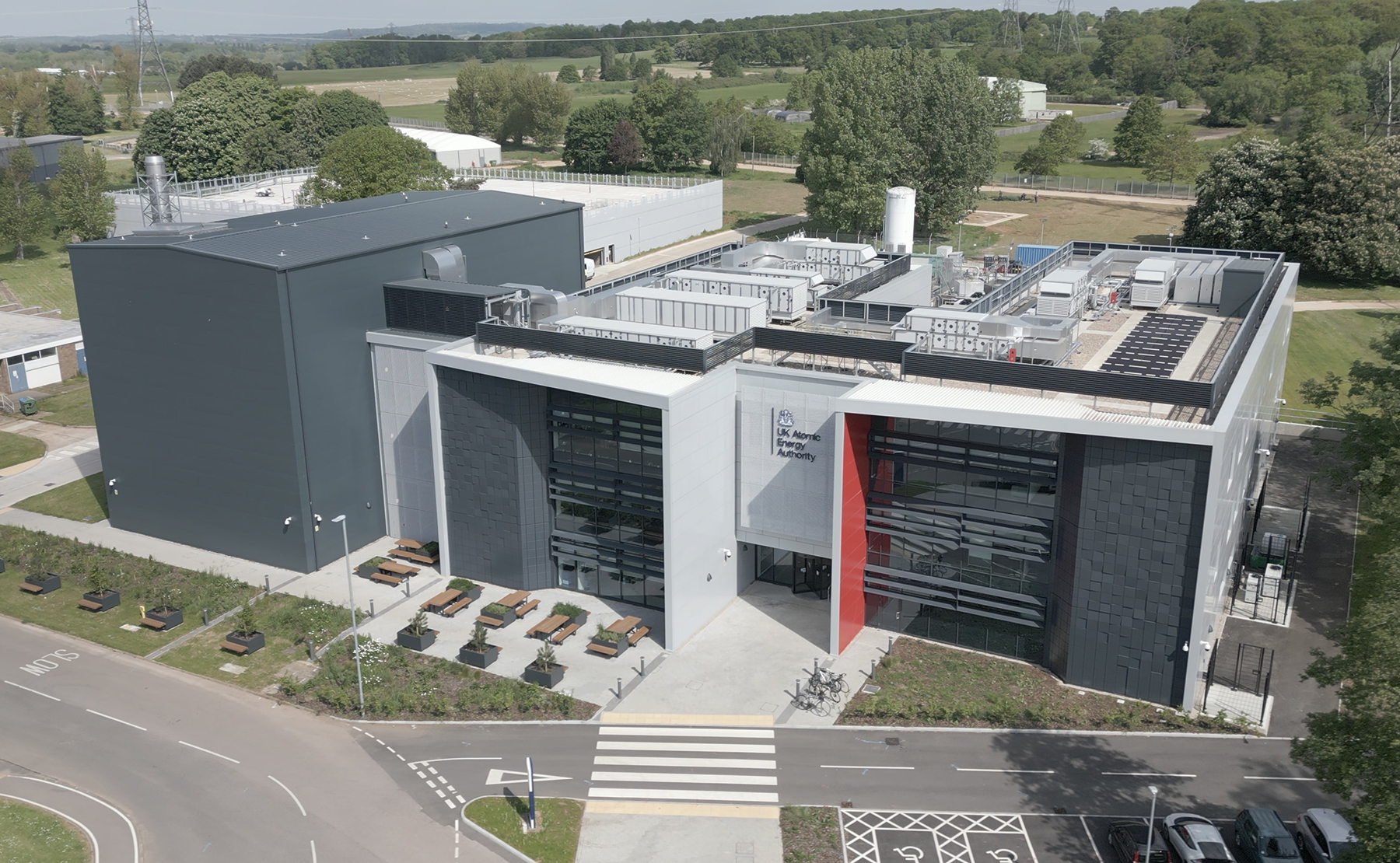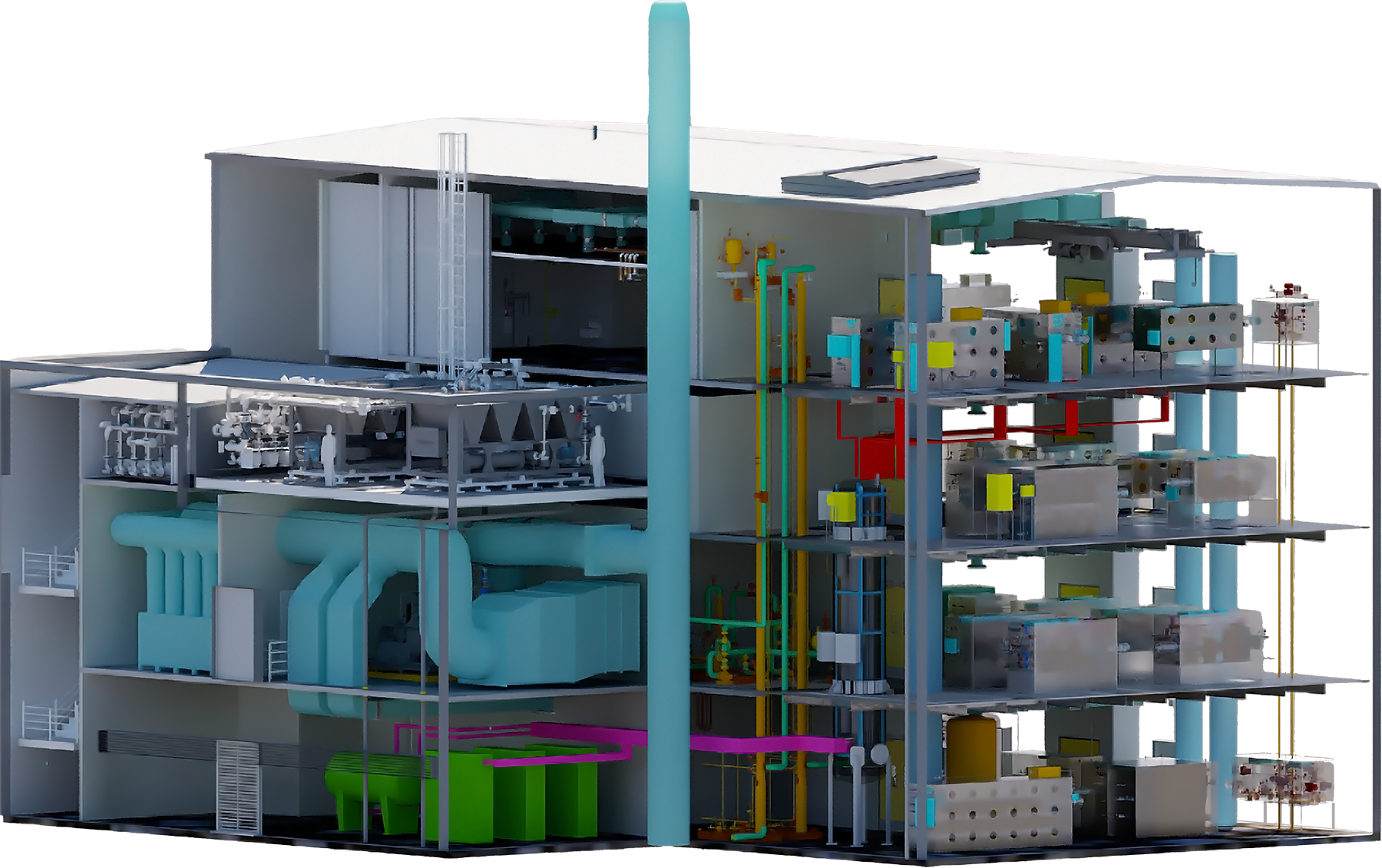 Courtesy of UKAEA
Courtesy of UKAEAAn upcoming facility in Culham, England, will study how the nuclear fusion industry can process, store, and recycle tritium in commercial power applications. The result of a collaboration between the United Kingdom Atomic Energy Authority and Italian multinational energy company Eni, the UKAEA-Eni H3AT Tritium Loop Facility will rank as the world’s largest tritium fuel-cycle facility when complete in 2028.
Fusion power has the potential to supply the world with clean, plentiful energy if the technology can overcome challenges such as power efficiency, heat management, and tritium supply. Tritium, a radioactive isotope of hydrogen with two neutrons, serves as a key ingredient to the fuel of many fusion reactor designs.
Further reading:
- Radiative cooling technologies offer solutions to extreme heat
- The renewable energy source right beneath our feet
- Multiuse sites make renewable energy more efficient and economically viable
The four-story H3AT building will provide flexible research spaces with separate closed-off areas in addition to the central fuel-cycle structure, which presents design challenges related to radiation and working with hydrogen.
According to a 2024 Fusion Industry Association report, the global fusion industry has grown from 1,096 employees across 23 companies in 2021 to 4,107 employees across 43 companies last year. Almost 70% of these companies are pursuing fusion using a deuterium-tritium fuel. This fuel mix, according to the U.S. Department of Energy, reaches fusion conditions at lower temperatures than other elements and releases more energy than other fuels.
Tritium scarcity
While deuterium, another isotope of hydrogen, occurs naturally in seawater, tritium is relatively rare as it decays with a short, 12-year half-life. Once operational, fusion plants will be expected to “breed” their own tritium by exposing enriched lithium to the stream of neutrons released from their reactors, says Sarah Clark, director of tritium fuel cycle at UKAEA. But the initial tritium needed to jump-start the industry remains in short supply. Almost 45% of companies in the Fusion Industry Association survey identified tritium self-sufficiency as a major near-term challenge.
“Tritium is currently produced in fission reactors, specifically those that rely on heavy water for cooling and moderation,” said Bassem El Dasher, a staff scientist at the Lawrence Livermore National Laboratory in Livermore, California. “As a byproduct of neutron interactions with the deuterium in the water, tritium is produced and subsequently separated electrolytically.”
Canada and South Korea rank as the world’s top tritium producers. Taken together, heavy-water reactors yield about 2 kilograms of tritium per year worldwide for commercial uses. A single fusion reactor will need about 1 kilogram per day for several days to establish its self-fueling cycle, says El Dasher, and possibly more, depending on its design.
But with planned fission-reactor retirements in Canada and delays in the ITER project – a large-scale magnetic fusion proof of concept that blocks subsequent, tritium-producing projects – a 2017 International Atomic Energy Agency paper casts serious doubts on whether the world would have enough tritium to start any fusion projects beyond the supply already earmarked for ITER and its successors. If heavy-water reactors begin their phaseouts earlier than expected, almost no tritium will be available for any fusion experiments.
Tritium’s scarce supply presents a major challenge for the industrialization of tritium-fed fusion devices.
In order to move the fusion industry along, reactor designs must minimize the tritium they need, according to the IAEA paper, and efficiency improvements to the fuel cycle are prime areas of focus.
H3AT will therefore serve as a platform to study a continuous, closed-loop fuel cycle that captures bred tritium and feeds it back into a reactor as fuel.
“The technology readiness of the individual components is there, but what we want to do, and one of the key challenges, is to essentially integrate those into the system,” Clark said. H3AT will include a torus vacuum simulator to evaluate how the individual components within the fuel cycle and the system’s design parameters react with one another as the reactor output varies.
“It is a very unique plant that will be very valuable to the fusion community,” Clark said.
Hazards and concerns
Tritium, a weak beta emitter, presents certain radiological hazards that the facility must account for. To mitigate risks, Clark says the team will minimize the amount of tritium stored in the facility at any given time. And for the tritium that is there, the team must ensure that it remains properly confined to prevent any possible releases to the workplace or surrounding environment.
“A key factor in that is around ensuring material compatibility with tritium because it’s a form of hydrogen, and it demonstrates many of the same behaviors as hydrogen,” Clark said. “It’s very permeable, and it can cause embrittlement of certain materials, so making sure that the materials that we select are compatible for the facility design is very critical.”
 Courtesy of UKAEA
Courtesy of UKAEA
Hydrogen embrittlement – the process in which atomic hydrogen reduces the fracture toughness and ductility of a metal – “usually (manifests) in terms of singular sharp cracks, in contrast to the extensive branching observed for stress-corrosion cracking,” according to a NASA technical memorandum by Jonathan A. Lee on the topic. When it occurs, hydrogen diffuses through metallic surfaces to react with internal compounds, bringing a material’s fracture loads down well below its yield strength if left unchecked.
“The initial crack openings and the local deformation associated with crack propagation may be so small that they are difficult to detect except in special nondestructive examinations,” Lee wrote. “Cracks due to (hydrogen embrittlement) can grow rapidly with little macroscopic evidence of mechanical deformation in materials that are normally quite ductile.”
Alloy steels with stable carbides tend to be less susceptible to this form of hydrogen attack, Lee continued. The hydrogen concentration, gas pressure, and temperature also play roles in the speed of the process.
In addition to its primary and secondary containment structures, H3AT will also be equipped with reassurance monitoring and an atmospheric detritiation system for tritium confinement.
Commercial fusion within 10 years
Despite the industry’s significant challenges, about 71% of the companies surveyed expect to put fusion power on the grid before 2035, including 9% that said they were aiming for before 2030.
Clark shares that optimism, saying that a recent series of fusion achievements have brought the industry closer to practical, commercial fusion power.
In 2022, the National Ignition Facility at the Livermore lab, with an inertial confinement design that uses the momentum of an imploding fuel capsule to initiate fusion, became the first facility to achieve “ignition,” where the amount of energy produced by the fusion reaction exceeded the amount of energy used to start it.
The UKAEA’s Joint European Torus, a magnetic-confinement design, then set the record in 2024 for fusion energy output, sustaining a consistent fusion reaction to produce 69 megajoules – about 19 kilowatt-hours – using 0.2 milligrams of fuel over five seconds.
And earlier this year, the French Alternative Energies and Atomic Energy Commission’s Tungsten Environment in Steady-State Tokamak set a record for plasma duration, maintaining a fusion plasma for over 22 minutes.
“It is an exciting time, I think, to work in fusion,” Clark said.
To generate commercial power, these reactions must repeat regularly, which requires a sufficient fuel supply in place to feed them. While the UKAEA already operated a tritium plant to supply JET, that plant produces tritium only in batches, Clark says. “The H3AT facility is the next stage in development of that, in that it will be a continuously operating fuel loop (at) pilot-plant scale.”
Eni added that one of its partners, Commonwealth Fusion Systems, “foresees the first-of-a-kind fusion power plant early next decade, with the subsequent scaling and deployment of the technology. The timeline between 2030 and 2040 is now becoming a reference point, as most private startups in the fusion sector are targeting this time frame.”



